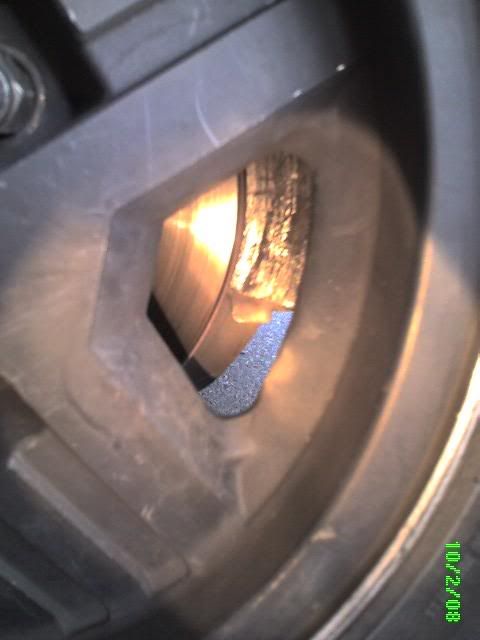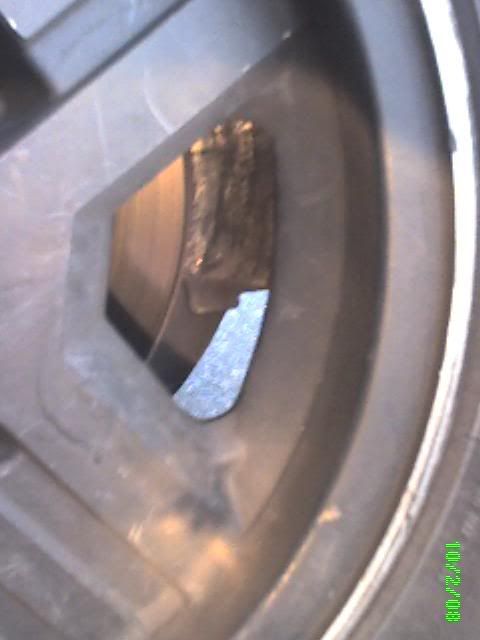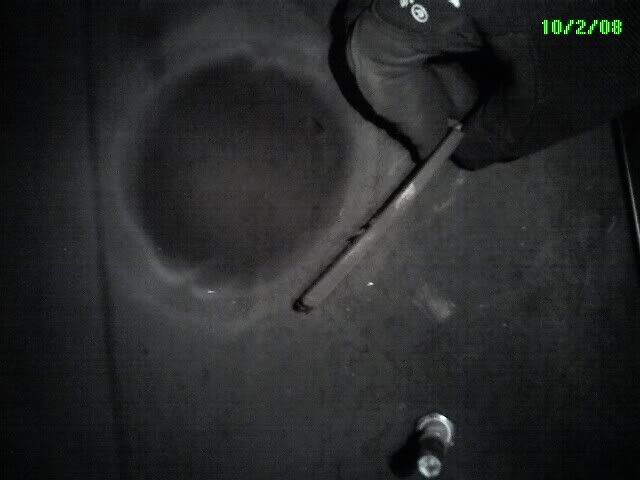My Fault or The Speed Bumps Fault,
#1
My Fault or The Speed Bumps Fault,
My Fault or The Speed Bumps Fault, You decide. So much for my FMOC swap.
I hit a speed bump at less than 10mph after that the pedal felt soft and it pulled left. 5 min later POP, grind. the right inner pad slipped between the bracket and the rotor and lodged between the front of the rotor and the dust shield.
I post this for my hatred of speed bump. I love Albuquerque, its a second home for me. But there is a speed bump every 4 feet. If its the last thing I do I'm going to get rid of every other speed bump. every other cause they is a need but this is over kill
So take a look, was it me or did the speed bump malishisly target my car in a unprovoked act violence!!



I hit a speed bump at less than 10mph after that the pedal felt soft and it pulled left. 5 min later POP, grind. the right inner pad slipped between the bracket and the rotor and lodged between the front of the rotor and the dust shield.
I post this for my hatred of speed bump. I love Albuquerque, its a second home for me. But there is a speed bump every 4 feet. If its the last thing I do I'm going to get rid of every other speed bump. every other cause they is a need but this is over kill
So take a look, was it me or did the speed bump malishisly target my car in a unprovoked act violence!!



#5
It's a mechanical failure which shouldn't have happened. A speed bump exerts less shock to the suspension than a pot hole will at street speeds. You need to find what failed and fix it.
#6
embarassing to admit it but i been so wraped up in the rear brakes and suspension. never inspected the front end. guess I'll do that tommorow.
Normally I pick a new car clean trying to find the last guys mistakes.........
Anyway you can best belive I'm still gonna write a strongly worded letter to the city counsel about speed bumps..... Then I'll finish my knitting.
Thanks guys
Normally I pick a new car clean trying to find the last guys mistakes.........
Anyway you can best belive I'm still gonna write a strongly worded letter to the city counsel about speed bumps..... Then I'll finish my knitting.
Thanks guys
Trending Topics
#8
When i picked up my car, im pretty sure something similar had happened to the PO.
There was no pad on the piston side of the caliper, so the caliper piston was pushing against the disc. Needless to say braking was FRIGHTENING. It would grind and then grab and lock and then resist. Took it off, piston/caliper was ratched and the disc was completely warped, eated and just basically destroyed.
No idea how it happened. Couldve just been neglect or something instaled poorly. I guess ill never know.
There was no pad on the piston side of the caliper, so the caliper piston was pushing against the disc. Needless to say braking was FRIGHTENING. It would grind and then grab and lock and then resist. Took it off, piston/caliper was ratched and the disc was completely warped, eated and just basically destroyed.
No idea how it happened. Couldve just been neglect or something instaled poorly. I guess ill never know.
#9
1st-Class Engine Janitor
iTrader: (15)
Joined: Jun 2008
Posts: 8,376
Likes: 28
From: Chino Hills, CA
Pad looks mighy thin; hard to see from the photos, but it looks like you were all the way through the friction material, and well into the metal.
Normally,there's no way for a pad to come out, as it's surrounded by the torque member (bottom and ends) , rotor face (inside), & caliper (top and outside).
But, if you had pads that were completely worn, AND you had rotors that were thinner than they should be, and/or bearings that were letting the rotor move too far outboard on the spindle... I can see how maybe the pad could get squeezed by the caliper, then rotational force would suck it out the gap between the torque member and the rotor.
Would never happen on parts within tolerance, but with too much wear in the pad and the rotor, I could make the argument. Also if the torque member was not properly bolted to the knuckle.
Bump would have been a contributing factor, just providing the extra force needed to provide clearance between the torque member and the rotor. Especially if the bearing is loose or bad.
Coulda been a lot worse. At least you didn't hit anything.
Inspect everything most carefully before assuming it's fixed. I'd recommend tearing that assembly down to the bare spindle and checking anything you plan to re-use very, very carefully.
Normally,there's no way for a pad to come out, as it's surrounded by the torque member (bottom and ends) , rotor face (inside), & caliper (top and outside).
But, if you had pads that were completely worn, AND you had rotors that were thinner than they should be, and/or bearings that were letting the rotor move too far outboard on the spindle... I can see how maybe the pad could get squeezed by the caliper, then rotational force would suck it out the gap between the torque member and the rotor.
Would never happen on parts within tolerance, but with too much wear in the pad and the rotor, I could make the argument. Also if the torque member was not properly bolted to the knuckle.
Bump would have been a contributing factor, just providing the extra force needed to provide clearance between the torque member and the rotor. Especially if the bearing is loose or bad.
Coulda been a lot worse. At least you didn't hit anything.
Inspect everything most carefully before assuming it's fixed. I'd recommend tearing that assembly down to the bare spindle and checking anything you plan to re-use very, very carefully.
Last edited by DivinDriver; 10-03-08 at 02:42 PM.
#10
Pad looks mighy thin; hard to see from the photos, but it looks like you were all the way through the friction material, and well into the metal.
Normally,there's no way for a pad to come out, as it's surrounded by the torque member (bottom and ends) , rotor face (inside), & caliper (top and outside).
But, if you had pads that were completely worn, AND you had rotors that were thinner than they should be, and/or bearings that were letting the rotor move too far outboard on the spindle... I can see how maybe the pad could get squeezed by the caliper, then rotational force would suck it out the gap between the torque member and the rotor.
Would never happen on parts within tolerance, but with too much wear in the pad and the rotor, I could make the argument. Also if the torque member was not properly bolted to the knuckle.
Bump would have been a contributing factor, just providing the extra force needed to provide clearance between the torque member and the rotor. Especially if the bearing is loose or bad.
Coulda been a lot worse. At least you didn't hit anything.
Inspect everything most carefully before assuming it's fixed. I'd recommend tearing that assembly down to the bare spindle and checking anything you plan to re-use very, very carefully.
Normally,there's no way for a pad to come out, as it's surrounded by the torque member (bottom and ends) , rotor face (inside), & caliper (top and outside).
But, if you had pads that were completely worn, AND you had rotors that were thinner than they should be, and/or bearings that were letting the rotor move too far outboard on the spindle... I can see how maybe the pad could get squeezed by the caliper, then rotational force would suck it out the gap between the torque member and the rotor.
Would never happen on parts within tolerance, but with too much wear in the pad and the rotor, I could make the argument. Also if the torque member was not properly bolted to the knuckle.
Bump would have been a contributing factor, just providing the extra force needed to provide clearance between the torque member and the rotor. Especially if the bearing is loose or bad.
Coulda been a lot worse. At least you didn't hit anything.
Inspect everything most carefully before assuming it's fixed. I'd recommend tearing that assembly down to the bare spindle and checking anything you plan to re-use very, very carefully.
I got lazy and forgot the basics. Ordered some EBC's and Hawks all around to apologize to "Her".
#11
Same thing happened to me,on a 1996 Mustang GT. I am fully aware that it was my fault. I let the brake pads wear way too much, should have replaced them but kept putting miles on 'em, we had little money back then. Then it pretty much grenaded one day. The pad fell out, and there were other small parts on the pavement. I was lucky to be able to limp back home. As was mentioned, it would lock every time brakes were applied, then I would have to go into reverse to break it loose. New pads, rotor and it was good as new. Never again.




